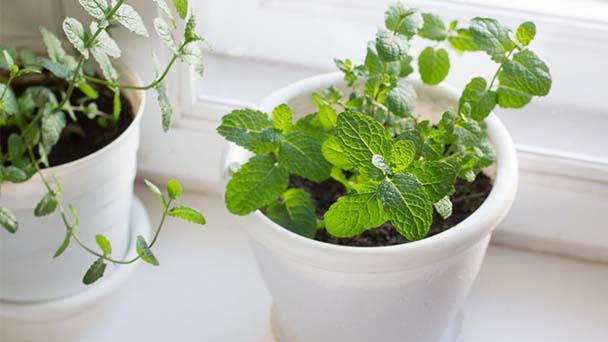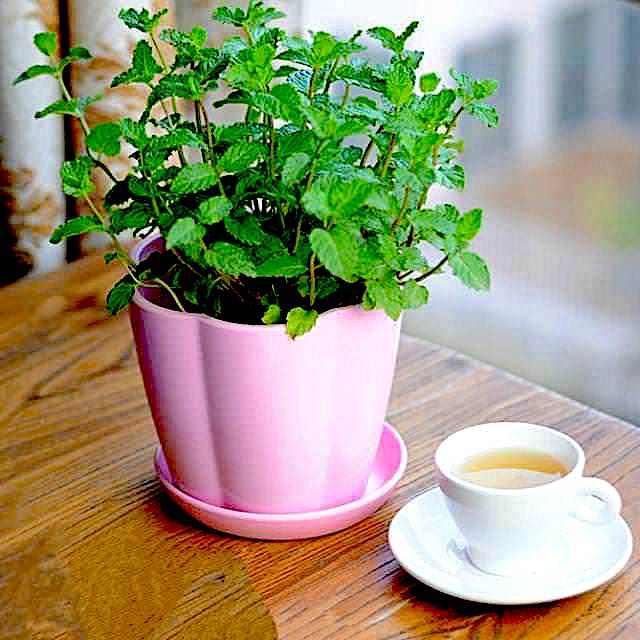Tips for growing Mint indoors
Written by Joy
Oct 22 2021


Peppermint likes moist and fertile alkaline soil, suitable temperature of growth 20 ~ 30℃, suitable temperature of germination 20 ~ 25℃. Key points of growing mint indoors: If the seeds of Mint indoors are sown and propagated, the seeds should be grown in the loam and not covered by light. The cultivated soil was prepared with 4 portions of well-drained loam and 1 portion of mixed organic fertilizer. Fertilize every 1 ~ 2 months. The aging plant needs pruning, and every spring you could strong repair to promote new branches and leaves.
Peppermint can refresh and relieve depression, treat a cold, headache, relieve heat and detoxification, strengthen stomach and abdominal distension, relieve inflammation and itch, and antisepsis. Pregnant women should be careful not to drink too much. Mint, alias Mint, fragrant mint, etc. It is a perennial herb. Its stem can make medicine, and have sparse wind, heat, detoxification through the role of rash. Menthol contains volatile oil, its main ingredients are menthol and menthol, which is the main raw material for menthol extraction. Mint prefers a warm, moist, sunny environment and it is suitable for growing Mint indoors..
Peppermint does not have strict requirements on soil, but it is better to take a loam with a deep soil layer, loose and fertile, rich in organic matter or semi-sandy loam. The suitable growth temperature is 20℃~33℃. Saline-alkali land, low-lying land is not suitable for planting. But rich loam and sandy loam are better. Mint should not be grown in shade because it needs sunshine .
Mint is usually propagated by rootstock, and can also be replanted and propagated by seed. The latter two methods are slow growing and easy to mutate, and are generally used less. The rhizome can be propagated in spring or before winter. The spring planting indoors can be carried out from late March to early April, and the pre-winter planting can be carried out around late October. Mint is best cut and planted at the same time to prevent the roots from drying out.
Sowing
Because the seeds are relatively small and the germination rate is low, the soil of growing Mint indoors needs to be loose, breathable, with high water holding capacity and seed sowing.Moisturize
After the beginner of growing Mint indoors seeds to water, a fine spray can avoid the seeds washed away. You'd better drain the basin and let the water sink in through the bottom hole. After sowing, you should cover the container with plastic wrap, puncture holes for ventilation, and then put it in the sunlight to keep it at about 20 degrees. Most seeds germinate after a week or two.Manage after germination
It 's time to remove the plastic wrap.Soil: The culture soil of growing Mint indoors can be garden soil, coarse sand, peat, organic fertilizer, according to the ratio of 4:3:2:1. What you need to be aware of is that the organic manure has to rot.
Water: you had better not pour directly to the leaf when growing Mint indoors, also do not let the earth splash to the leaf, lest produce disease, which can lay a layer of small stone on the earth surface, beautiful prevent disease again, tap water had better bask in two days to use again under the sun.
Fertilizer: You can use expired milk, lactic acid bacteria, rice water, eggshells when growing Mint indoors, and avoid artificial chemical fertilizers.
Check our article on 35 Most Common House Plants with Pictures & Care Guide
Latest Updated
- Benefits of Bugleweed - 7 Science-backed Health Benefits
- Bugleweed Dangers & Side Effects - Is It Poisonous?
- How to Plant Evergreen Trees - What You Should Know
- When to Plant Evergreens - Grow Guide for Evergreen Trees
- 12 Wonderful Evergreen Shrubs for Your Garden
- 12 Popular Evergreen Plants with Pictures for Beginners
- When And How To Prune A Lilac Bush Like a Pro
- How to Grow & Care for Lilac Vine (Hardenbergia Violacea)
- Japanese Lilac Tree (Syringa Reticulata) Care & Propagation Guide
- Shumard Oak Pros and Cons - What to Know
Popular Articles
- Winter maintenance of Antirrhinum Majus
- How to Grow Terminalia Mantaly Tree
- How to Grow and Care for Crossostephium Chinense
- How to grow Antirrhinum Majus in spring
- Peristeria Elata (Dove Orchid) Profile: Info & Care Guide
- Underwatered Snake Plant (Sansevieria Trifasciata) - Signs And How To Fix
- How to Care for Brazilian Jasmine Plant (Mandevilla Sanderi)
- How to Grow & Care for Graptopetalum Purple Delight in Summer
- Rosa Chinensis (China Rose): Plant Growing & Care Tips
- How to Care for Baby Sun Rose (Aptenia Cordifolia)